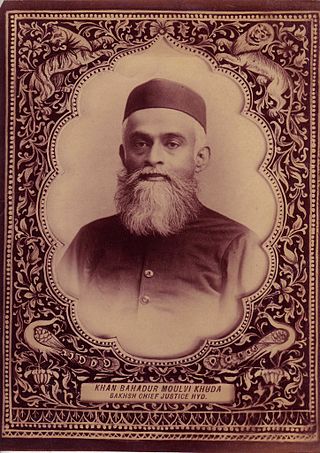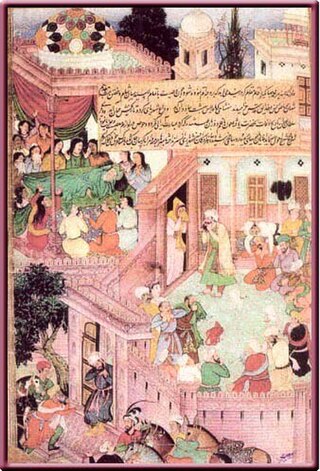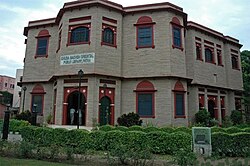
Makhdoom Yahiya Maneri was an Indian Sufi saint of the 13th century. His tomb in courtyard of a mosque, located in Maner, 29 km from Patna, Bihar, India.

Gazipur is a district in central Bangladesh that is part of the Dhaka Division. It has an area of 1741.53 km2. It is the home district of Tajuddin Ahmad, the first Prime Minister of Bangladesh and has been a prominent centre of battles and movements throughout history. Gazipur is home to the Bishwa Ijtema, the second-largest annual Muslim gathering in the world with over 5 million attendees. The district is home to numerous universities, colleges, the Bangabandhu Sheikh Mujib Safari Park, Bhawal National Park as well as the country's only business park - the Bangabandhu Hi-Tech City.

Padshahnama or Badshah Nama is a group of works written as the official history of the reign of the Mughal Emperor Shah Jahan I. Unillustrated texts are known as Shahjahannama, with Padshahnama used for the illustrated manuscript versions. These works are among the major sources of information about Shah Jahan's reign. Lavishly illustrated copies were produced in the imperial workshops, with many Mughal miniatures. Although military campaigns are given the most prominence, the illustrations and paintings in the manuscripts of these works illuminate life in the imperial court, depicting weddings and other activities.

Alivardi Khan was the Nawab of Bengal from 1740 to 1756. He toppled the Nasiri dynasty of Nawabs by defeating Sarfaraz Khan in 1740 and assumed power himself.

Kapasia is an upazila (sub-district) of Gazipur District in central Bangladesh, part of the Dhaka Division. It is located at 24.1000°N 90.5708°E, and is best known as the home upazila of Tajuddin Ahmad, the first Prime Minister of Bangladesh. The modern-day upazila was a part of the historic Bhawal Estate and falls within its boundary.

The national language and official language of Bangladesh is Bangla according to the third article of the Constitution of Bangladesh. The second most spoken language in Bangladesh is claimed to be Burmese which is spoken by the Marma tribe in Chittagong Hill districts as the districts border Myanmar; it is also spoken by the Rohingya people. Almost 99% of Bangladeshis speak Bengali as their first language. Bengali Language Implementation Act, 1987 made it mandatory to use Bengali in all government affairs except in the cases of foreign relations. According to a 2022 census, Bengali is predominantly spoken by 99% of the country's population and it also serves as the national language of the nation. The indigenous people of northern and southeastern Bangladesh speak a variety of native languages. According to the Ethnologue, there are 36 indigenous living languages, which include 17 Tibeto-Burman, 10 Indo-Aryan, 7 Austroasiatic and 2 Dravidian languages in Bangladesh. Bangladesh has 44 indigenous languages according to Professor Shameem Reza.

The National Mission for Manuscripts (NAMAMI) is an autonomous organisation under Ministry of Culture, Government of India, established to survey, locate and conserve Indian manuscripts, with an aim to create national resource base for manuscripts, for enhancing their access, awareness and use for educational purposes. The Mission was initiated in February 2003, by the Ministry of Tourism and Culture, Government of India and Indira Gandhi National Centre for the Arts is the nodal agency for the execution of this project. It creates bibliographic databases of Indian manuscripts and is involved in the conservation and preservation of the manuscripts.
Bankipur is a neighbourhood and residential area in Patna, in the Indian state of Bihar. It is located on the bank of the river Ganges. The prime attraction is the Khuda Bakhsh Oriental Library built by Khan Bahadur Khuda Bakhsh in 1891 and Golghar granary that was built by Captain John Garstin in 1786. Patna Dental College and Hospital is also located here.

Patna College is a constituent state aided College of Patna University which was established in 1863 during the British Raj. It offers undergraduate and postgraduate courses in science, arts and commerce as well as some vocational courses like BBA, BMC and BCA. The college is affiliated to Patna University. It is also considered to be the oldest institution of higher education in Bihar.
Ziauddin Abdul Hayy Desai was an Indian epigraphist associated with the Archaeological Survey of India (ASI). He was also a noted architectural historian and a literary scholar of the Indo-Persianate world as evidenced in his writings.
Bismil Azimabadi was an Indian freedom fighter, landlord, and an Urdu poet from Patna, the capital of Bihar.
Majid Ali Jaunpuri was an Indian Sunni Islamic scholar and a rationalist thinker. He was mainly known for his work in the subjects of logic and hadith. He was an alumnus of the Darul Uloom Deoband and is reported to have written a marginalia to Sunan Abu Dawud and Jami` at-Tirmidhi.
Hafizur Rahman Wasif Dehlavi was an Indian Muslim scholar, jurist, literary critic, and a poet of the Urdu language, who served as the rector of Madrasa Aminia from 1955 to 1979. He participated in the Indian freedom struggle movement and authored books such as Adabī bhūl bhulayyān̲, Urdū Masdar Nāmā and Taz̲kirah-yi Sā'il. He compiled the religious edicts of his father Kifayatullah Dehlawi as Kifāyat al-Mufti in nine volumes.

Sir Khan Bahadur Khuda Bakhsh OIE FRAS was an Indian advocate, judge, philosopher, revolutionary freedom fighter, scholar and historian from Patna, Bihar. He was the founder of Khuda Bakhsh Oriental Library and Chief Justice of Nizam's Supreme Court of Hyderabad from 1895 to 1898. Khuda bakhsh maintains a strong legacy across the Islamic World for his contributions to Literature and History.

Shāh Nūrī Bengālī was an 18th-century Bengali Islamic scholar and author from Dhaka. He is best known for his magnum opus, Kibrīt-e-Aḥmar, which was written in the Persian language.
Dr. Shayesta Bedar is an Indian historian, academician and scholar who is currently serving as the Director of Khuda Bakhsh Oriental Public Library, Patna. Before joining the National library, she has served as an Assistant librarian in Maulana Azad LibraryAMU, Aligarh from as in-charge of the Manuscript section of the library where she established a library museum in Maulana Azad Library. She has authored numerous research papers based on Persian and Urdu literature. Additionally, she has edited and compile work for a variety of books related to Persian, Hindi and Urdu literature.

Tarikh e Khandan e Timuriyah also known as "Chronicle of the Descendants of Timur" is a 16th-century manuscript which was prescribe by Mughal Emperor Akbar. It gives the details about the descendant of Timur in Iran and India It was produced during Emperor Akbar's reign in 1577–1578, this volume was crafted for the emperor's personal use thus, securing a treasured place in his personal library. This volume, was inscribed on the finest paper, boasts a collection of 133 paintings, collaboratively crafted by 51 prominent artists like Daswant, Miskin, Madho Mukund, Haidar Kashmiri, Miskeen, Manohar and Basawan. These intricately detailed and refined paintings exemplify the pinnacle of Mughal artistic expression. The written text has calligraphy that matches the standards set by the artwork.
Ali Ibrahim Khan, also known as Khalil Azimabadi (1714–1793), was an 18th-century Indian statesman and literary figure from Patna, then known as Azimabad.
Khanqah-e-Mujibia is a building at Phulwari Sharif, Patna district in the Indian state of Bihar that consists of Madrasa Mujibia, Dargah-e-Mujibia and other educational Institutions. It was named after Syed Shah Mujibullah Qadri, the founder and a Sufi saint of Qadiriyya order.












